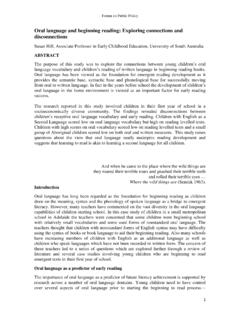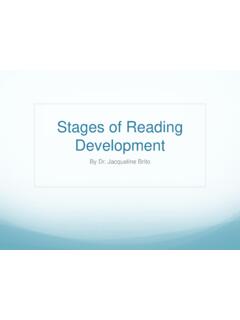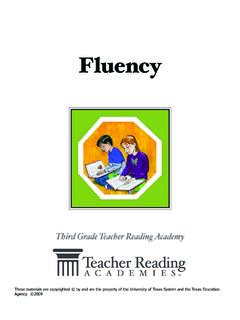Transcription of Scaffolding Reading Comprehension Skills - ed
1 English Language Teaching; Vol. 10, No. 1; 2017 ISSN 1916-4742 E-ISSN 1916-4750 Published by Canadian Center of Science and Education 97 Scaffolding Reading Comprehension Skills Ashraf Atta Mohamed Safein Salem1 1 Department of Languages & Linguistics, College of Business Administration, Sadat Academy for Management Sciences, Egypt Correspondence: Ashraf Atta Mohamed Safein Salem, Department of Languages & Linguistics, College of Business Administration, Sadat Academy for Management Sciences, Egypt.
2 E-mail: Received: November 23, 2016 Accepted: December 22, 2016 Online Published: December 24, 2016 doi: URL: Abstract The current study investigates whether English language teachers use Scaffolding strategies for developing their students Reading Comprehension Skills or just for assessing their Comprehension . It also tries to demonstrate whether teachers are aware of these strategies or they use them as a matter of habit. A questionnaire as well as structured interviews were basically designed for the purpose of the study.
3 The descriptive qualitative research design was adopted due to suitability for the nature of the study. Results of the study revealed that Non-native English language teachers are not aware of the nature of Scaffolding strategies they use; they use such strategies for the purpose of assessing their students Comprehension rather than Scaffolding their Comprehension . It is recommended that English language teachers have an adequate orientation of the nature of Scaffolding strategies, to what extent to be used (when to begin using these strategies and when to stop using them) and the significance in developing Comprehension Skills of students in the mainstream schools.
4 Keywords: Scaffolding strategies, Reading Comprehension , non-native English language teachers 1. Introduction Reading is an essential skill for academic success (Levine, Ferenz, & Reves 2000). Hence, it is a perquisite to almost all graduate programs however most students suffer from deficiencies in Reading (Farhady & Sajadi, 1999). It is not only a useful skill in academic contexts but it is also crucial for daily life as people read to get information about specific topics (Farhady, 2005, p.)
5 1). Traditionally, Reading is viewed as a passive receptive skill that happens in a separate environment. In the process of Reading , readers usually respond to the meaning of words and sentences (Pressley, El-Dinary, Wharton-McDoland, and Brown as cited in Royanto, 2012). Reza and Mahmood (2013) points out, it was viewed as a purely individualistic skill that has been looked from a completely different perspective (p. 67). Readers depend mainly on their background knowledge and the wide vocabulary stock they have in order to understand the Reading materials as well as making logical conclusions (Reed, 1982; French, Ellsworth, & Amoroso, 1995).
6 This repertoire of knowledge which is referred to as a schemata helps in representing meaning in the connected discourse (Anderson, Spiro, & Anderson, 1977). A recent viewpoint of Reading was proposed by Lev Vygotsky (1978) through the socio-cultural theory of learning (Lantolf 2006; Remi & Lawrence, 2012). In the light of such theory, Reading is viewed as a social skill that requires an active participation, interaction and involvement of learners (Reza & Mahmood, 2013). Two main metaphors lay behind Vygotsky s work in the socio-cultural theory in learning; Scaffolding and Zone of Proximal Development (ZPD).
7 ZPD represents a pivotal concept in the socio-cultural theory that explicates the important role of teachers as mediators; it s the heart of the concept of Scaffolding (Clark & Graves, 2004; Huong, 2003; Kozulin, 2004; Lantolf & Poehner, 2008; Lantolf & Thorne, 2006, Reza & Mahmoud, 2013). ZPD is referred to as: What an individual can accomplish when working in collaboration with others versus what he or she could have accomplished without collaboration with others (Zuengler & Miller 2006, p. 39). ZPD is the core element of Vygotsky s theory as it refers to a distinguishing point between students performance when they are not guided or helped by other people.
8 Logically, students performance when guided to some extent by their tutors or teachers outpowers performance of their counterparts who do not receive any help and guidance. English Language Teaching Vol. 10, No. 1; 2017 98 The essence of help, guidance and monitoring represents the core of the second metaphor proposed by Wood, Bruner and Ross (1976) in their examination of parent-child talk in the early years (Gibbons, 2002). It is really an excellent metaphor for describing strategies used for helping and guiding students to learn high-order thinking Skills , it is referred to as Scaffolding strategies.
9 Building workers in under construction need scaffolds to help them to do certain tasks and to reach high places. Hence, scaffolds are temporary, used to achieve certain tasks then they should be removed. In educational contexts, instructional scaffolds are temporarily used to help and guide students to learn and practice Skills such as the language Skills . These scaffolds are gradually removed bit by bit in order to allow student to feel independence from teacher s surveillance and control to feel free to learn on their own.
10 Scaffolding can be provided by experts as well as more experienced people around the student; teachers, parents, and even peers at the same class. Yet, planned instructional scaffolds are often provided by teachers (Benson, 1997; Lipscomb, Swanson, & West, 2004; Haghparast & Mall-Amiri, 2015). Well-constructed Scaffolds optimize student learning, provide a supportive environment as well as facilitating student independence. Scaffolding strategy refers to supporting students to certain extent until the degree of acquiring new Skills in an individual basis (Rosenshine & Meister, 1992; Lorkin, 2002).



















